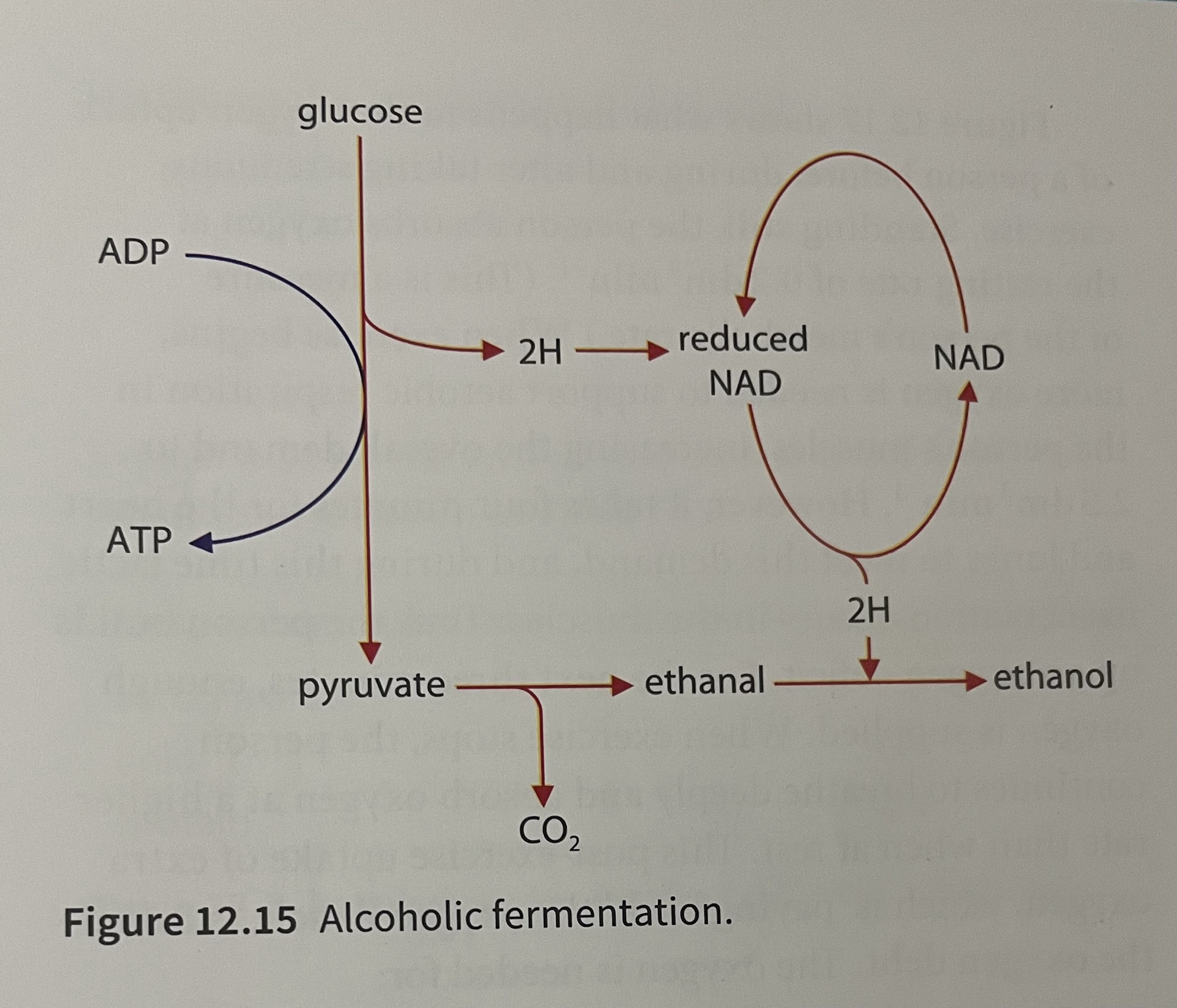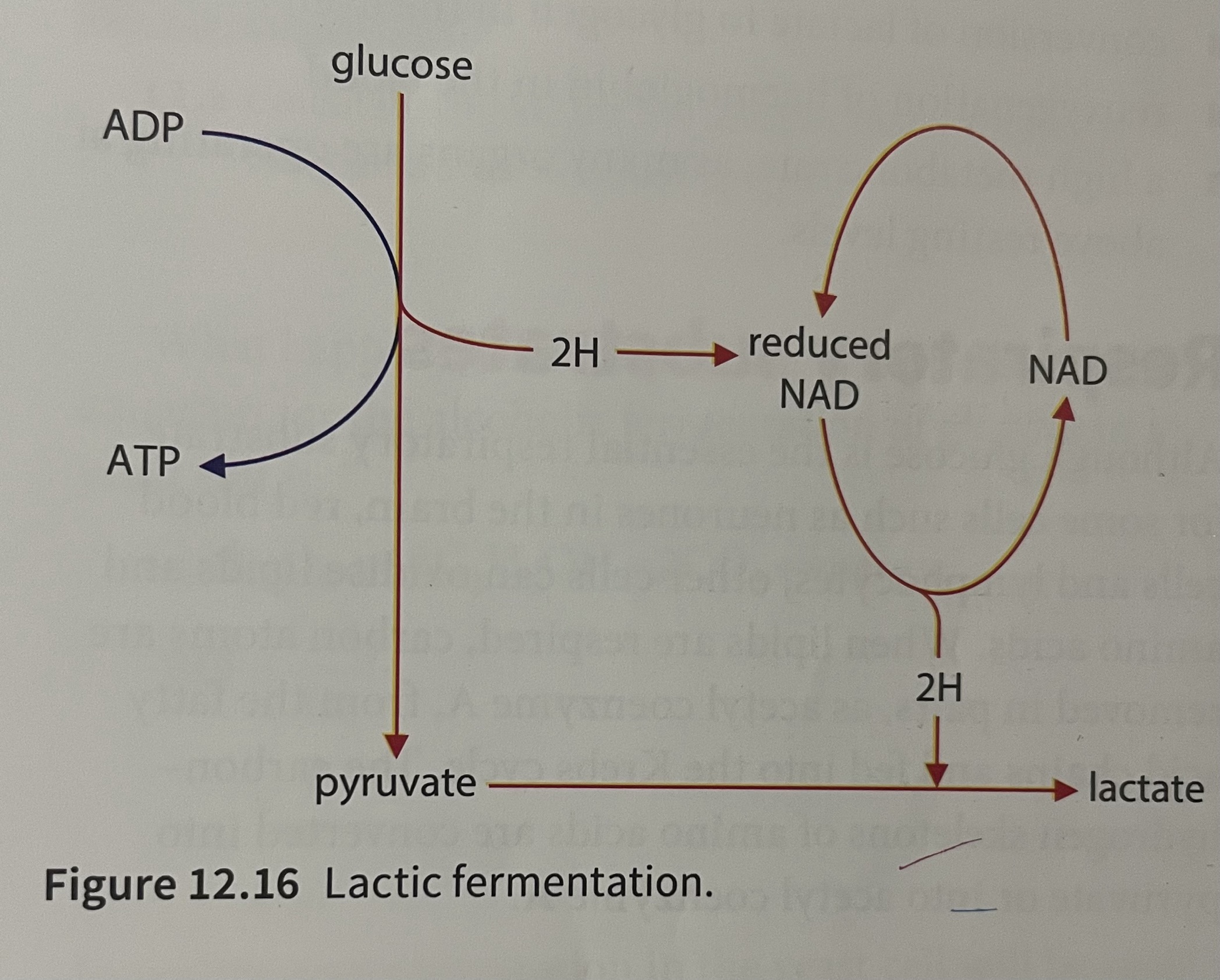Energy and Respiration
1/30
Earn XP
Description and Tags
Name | Mastery | Learn | Test | Matching | Spaced |
|---|
No study sessions yet.
31 Terms
Why is ATP used for energy?
ATP is tri-phosphorylated, so the removal of each phosphate releases energy
ATP is easily hydrolysed and water soluble making it useful source of energy
List the four stages of aerobic respiration and state where they occur
Glycolysis - cytoplasm
Link reaction - Mitochondrial matrix
Kreb’s cycle - Mitochondrial matrix
Oxidative phosphorylation - Inner mitochondrial membrane
Outline the stages of glycolysis
Glucose is phosphorylated to hexose bisphospahte by 2 ATP molecules
Hexose bisphosphate splits into to triose phosphates (TP)
2 molecules of TP are oxidised to form 2 pyruvates
Net gain: 4 NADH, 2 ATP
How does pyruvate from glycolysis enter the mitcohondria?
Via active transport
What happens during the link reaction?
Oxidative decarboxylation and dehydrogenation of pyruvate to form acetate
Net gain of CO2 and 2 NADH
Acetate combines with coenzyme A (CoA) to form acetyl coenzyme A
Define ‘substrate level phosphorylation’
The synthesis of ATP by the transfer of a phosphate group from a phosphorylated intermediate to ADP
What happens in the Krebs cycle?
Begins when Acetyl CoA (2C) reacts with oxaloacetate to form citrate
Citrate is decarboxylated and dehydrogenated to produce CO2 as a waste gas and hydrogens which are accepted by NAD and FAD
Oxaloacetate is regenerated to combine with another acetyl CoA
Net Gain: 2 CO2 and 1 ATP (1 FAD and 3 NAD molecules are reduced)
Why is the Krebs cycle important?
It breaks down macromolecules (pyruvate into smaller ones (CO2)
Produces hydrogen for electron carries that are used in the ETC
Regenerates 4C molecule which combines with acetylcoA
Source of intermediate compounds used by cells in the manufacture of important substances (fatty acids, amino acids, chlrophyll)
What is the electron transport chain (ETC)?
Series of carrier proteins embedded in the membrane of the cristae of the mitochondria
Produces ATP through oxidative phosphorylation via chemiosmosis during aerobic respiration
What happens after the electron transport chain?
Electrons released from reduced NAD and FAD as they undergo successive redox reactions
The energy released is coupled to maintaining the proton gradient or is released as heat
Oxygen acts as the final electron acceptor
How does chemiosmosis produce ATP during aerobic respiration?
Some energy released from the ETC is coupled to the active transport of H+ from the mitochondrial matrix into the intermembrane space
H+ ions move down their concentration gradient into the mitochondrial matrix vi athe channel protein ATP synthase
ADP + Pi ——> ATP (ATP synthase catalyst)
State the role of oxygen in the electron transport chain
Final electron acceptor
O2 + 4H+ + 4e- ——> 2H2O
State the stages in respiration that produce ATP by substrate-level phosphorylation
Glycolysis (anaerobic)
Krebs cycle (aerobic)
What are the two types of anaerobic respiration?
Ethanol formation
Lactate formation
What does ethanol formation involve?
The conversion of pyruvate to ethanol without the presence of O2
Takes place in plants and yeast
Outline the ethanol fermentation process
Pyruvate is converted to ethanal by pyruvate decarboxylase and CO2 is the by-product
Ethanal is reduced by NADH and forms ethanol
NAD is regenerated for glycolysis
Less ATP is produced than in aerobic

Outline the Lactate formation process
Only glycolysis continues
NADH transfers its hydrogen to pyruvate to form lactate forming NAD and lactic acid
Lactate dehydrogenase catalyses the reaction
Lactate is converted back to pyruvate when sufficient oxygen in present

In which organisms does the lactate fermentation process take place?
Animals and some bacteria
Common in skeletal muscles when there is insufficient oxygen supply
What happens to lactate after it is produced?
It can be oxidised to pyruvate and that pyruvate is sent to the krebs cycle for ATP production
It can be converted into glycogen for storage in the liver
Name two types of molecule that can be used as alternative respiratory substrates
Proteins (amino acids)
Lipids (glycerol and fatty acids)
Compare the efficiency of aerobic and anaerobic respiration
Aerobic is 16.2% more efficient than anaerobic
Aerobic efficient = 34%
Anaerobic efficient = 2.1%
Define the term oxygen debt
The amount of additional O2 needed after exercise to return the body back to its previous state
What is the equation for oxygen deficit?
The volume of O2 required during exercise minus volume of O2 obtained
How is rice adapted for growth in low oxygen environment?
Rice grows with its roots submerged in water so they depend on ethanol fermentation to get a lot of their energy
Aerenchyma in the stem allows gases to move to submerged parts of the plant so that oxygen can enter the roots for aerobic respiration
The root cells also produce alcohol dehydrogenase to offset ethanol toxicity from anaerobic respiration
How can DCPIP be used to measure respiration in yeast?
To establish the chemiosmotic gradient, H+ is pumped out of the matrix
H+ reduces DCPIP producing a colour change from blue to colourless
The rate of the colour change allows the rate of respiration to be measured
What is respirometer?
A device used to determine the respiration rate in living organisms by measuring the change in volume of oxygen or carbon dioxide
What is the equation used when calculating the rate of respiration using a respirometer?
Volume of O2 produced or CO2 consumed/ time x mass of sample
Volume= distance moved by coloured drop x (0.5 x capillary tube diameter)2 π
What is the respiratory quotient?
Ratio of CO2 produced to O2 consumed
RQ = CO2/O2
What is the respiratory quotient for carbohydrates, lipids and proteins?
Carbohydrates: 1
Lipids: 0.7-0.72
Proteins: 0.8-0.9
What could an RQ of greater than 1 indicate?
May indicate the the conversion of carbohydrates to lipids
RQ for anaerobic respiration is infinity
Why do different respiratory substrates have different relative energy values?
Depends on the number of hydrogen in the structure which are oxidised to water